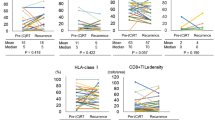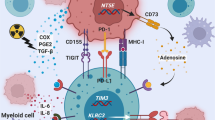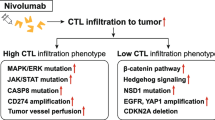Abstract
Background
Cancer immunotherapy with NKT cells is a potential new treatment strategy for advanced head and neck cancer. NKT cell therapy is promising due to its unique anti-tumor activity and higher degree of safety compared to current therapies. Radiotherapy is indispensable as a standard treatment for advanced head and neck cancer. To elucidate the possibility of using NKT cells as an adjuvant immunotherapy with radiotherapy, we examined the effect of radiotherapy on NKT cells in patients with head and neck cancer.
Methods
The number, IFN-γ production and proliferation capacity of NKT cells were analyzed before and after 50 Gy radiation therapy in 12 patients with stage IV head and neck squamous cell carcinoma. The cytotoxic activity of NKT cells was examined in vitro.
Results
The number of NKT cells in the blood varied widely between patients. After radiation therapy, the population of CD3 T cells decreased significantly, while the NKT cell population remained stable. The number of NKT cells was the same after radiation therapy as before. IFN-γ production from NKT cells collected just after radiotherapy was impaired after stimulation with exogenous ligand, but the proliferative responses of these NKT cells was enhanced in comparison to those collected before radiation therapy. Furthermore, the proliferated NKT cells displayed a significant level of anti-tumor activity.
Conclusion
NKT cells are relatively resistant to radiation and might therefore be suitable for adjuvant immunotherapy to eradicate remnant cancer cells in patients who have undergone radiation therapy.





Similar content being viewed by others
Abbreviations
- α-GalCer:
-
α-Galactosylceramide
- APCs:
-
Antigen presenting cells
- CTCAE:
-
Common terminology criteria for adverse events
- DCs:
-
Dendritic cells
- E/T:
-
Effector cell/target cell
- GM-CSF:
-
Granulocyte macrophage colony stimulating factor
- mAbs:
-
Monoclonal antibodies
- NK:
-
Natural killer
- NKT:
-
Natural killer T
References
Hainsworth JD, Meluch AA, McClurkan S, Gray JR, Stroup SL, Burris HA III, Yardley DA, Bradof JE, Yost K, Ellis JK, Greco FA (2002) Induction paclitaxel, carboplatin, and infusional 5-FU followed by concurrent radiation therapy and weekly paclitaxel/carboplatin in the treatment of locally advanced head and neck cancer: a phase II trial of the Minnie Pearl Cancer Research Network. Cancer J 8:298–300
Zelefsky MJ, Harrison LB, Fass DE, Armstrong J, Spiro RH, Shah JP, Strong EW (1993) Postoperative radiotherapy for oral cavity cancers: impact of anatomic subsite on treatment outcome. Head Neck 12:470–475
Clark J, Li W, Smith G, Shannon K, Clifford A, McNeil E, Gao K, Jackson M, Mo Tin M, O’Brien C (2005) Outcome of treatment for advanced cervical metastatic squamous cell carcinoma. Head Neck 27:87–94
Hicks WL Jr, Loree TR, Garcia RI, Maamoun S, Marshall D, Orner JB, Bakamjian VY, Shedd DP (1997) Squamous cell carcinoma of the floor of mouth: a 20-year review. Head Neck 19:400–405
Metelmann HR (2000) Chemotherapy and radiochemotherapy in tumors of the head–neck area. Mund Kiefer Gesichtschir 4(suppl 1):S155–S159
Wanebo HJ, Glicksman AS, Landman C, Slotman G, Doolittle C, Clark J, Koness RJ (1995) Preoperative cisplatin and accelerated hyperfractionated radiation induces high tumor response and control rates in patients with advanced head and neck cancer. Am J Surg 170:512–516
Beatty JD (1992) Immunotherapy of colorectal cancer. Cancer 70:1425–1433
Cortesina G, De Stefani A, Sacchi M, Rosso S, Galeazzi E (1993) Immunomodulation therapy for squamous cell carcinoma of the head and neck. Head Neck 15:266–270
Gualde N, Goodwin JS (1984) Effect of irradiation on human T-cell proliferation: low dose irradiation stimulates mitogen-induced proliferation and function of the suppressor/cytotoxic T-cell subset. Cell Immunol 84:439–445
Rose H, Moldenhauer H, Kehrberg G (1985) Lymphocyte damage caused by ionizing radiation. Radiobiol Radiother 26:289–297
Vicari AP, Zlotnik A (1996) Mouse NK1.1+ T cells: a new family of T cells. Immunol Today 17:71–76
Taniguchi M, Koseki H, Tokuhisa T, Masuda K, Sato H, Kondo E, Kawano T, Cui J, Perkes A, Koyasu S, Makino Y (1996) Essential requirement of an invariant Vα14 T cell antigen receptor expression in the development of natural killer T cells. Proc Natl Acad Sci USA 93:11025–11028
Bendelac A, Rivera MN, Park SH, Roark JH (1997) Mouse CD1-specific NK1 T cells: development, specificity, and function. Annu Rev Immunol 15:535–562
Hameg A, Apostolou I, Leite-De-Moraes M, Gombert JM, Garcia C, Koezuka Y, Bach JF, Herbelin A (2000) A subset of NKT cells that lacks the NK1.1 marker, expresses CD1d molecules, and autopresents the alpha-galactosylceramide antigen. J Immunol 165:4917–4926
Nicol A, Nieda M, Koezuka Y, Porcelli S, Suzuki K, Tadokoro K, Durrant S, Juji T (2000) Human invariant valpha24+ natural killer T cells activated by alpha-galactosylceramide (KRN7000) have cytotoxic anti-tumor activity through mechanisms distinct from T cells and natural killer cells. Immunology 99(2):229–234
Seino K, Motohashi S, Fujisawa T, Nakayama T, Taniguchi M (2006) Natural killer T cell-mediated antitumor immune responses and their clinical applications. Cancer Sci 97:807–812
Molling JW, Kölgen W, van der Vliet HJ, Boomsma MF, Kruizenga H, Smorenburg CH, Molenkamp BG, Langendijk JA, Leemans CR, von Blomberg BM, Scheper RJ, van den Eertwegh AJ (2005) Peripheral blood IFN-gamma-secreting Valpha24 + Vbeta11 + NKT cell numbers are decreased in cancer patients independent of tumor type or tumor load. Int J Cancer 116:87–93
Motohashi S, Ishikawa A, Ishikawa E, Otsuji M, Iizasa T, Hanaoka H, Shimizu N, Horiguchi S, Okamoto Y, Fujii S, Taniguchi M, Fujisawa T, Nakayama T (2006) A phase I study of in vitro expanded natural killer T cells in patients with advanced and recurrent non-small cell lung cancer. Clin Cancer Res 12:6079–6086
Uchida T, Horiguchi S, Tanaka Y, Yamamoto H, Kunii N, Motohashi S, Taniguchi M, Nakayama T, Okamoto Y (2008) Phase I study of alpha-galactosylceramide-pulsed antigen presenting cells administration to the nasal submucosa in unresectable or recurrent head and neck cancer. Cancer Immunol Immunother 57:337–345
Knii N, Horiguchi S, Motohashi S, Yamamoto H, Ueno N, Yamamoto S, Sakurai D, Taniguchi M, Nakayama T, Okamoto Y (2009) Combination therapy of in vitro-expanded natural killer T cells and alpha-galactosylceramide-pulsed antigen-presenting cells in patients with recurrent head and neck carcinoma. Cancer Sci 100:1092–1098
Ogawa Y, Kobayashi T, Nishioka A, Kariya S, Ohnishi T, Hamasato S, Seguchi H, Yoshida S (2004) Reactive oxygen species-producing site in radiation-induced apoptosis of human peripheral T cells: involvement of lysosomal membrane destabilization. Int J Mol Med 13:69–73
Molling JW, Langius JA, Langendijk JA, Leemans CR, Bontkes HJ, van der Vliet HJ, von Blomberg BM, Scheper RJ, van den Eertwegh AJ (2007) Low levels of circulating invariant natural killer T cells predict poor clinical outcome in patients with head and neck squamous cell carcinoma. J Clin Oncol 25:862–868
Kajioka EH, Andres ML, Li J, Mao XW, Moyers MF, Nelson GA, Slater JM, Gridley DS (2000) Acute effects of whole-body proton irradiation on the immune system of the mouse. Radiat Res 153:587–594
Crough T, Purdie DM, Okai M, Maksoud A, Nieda M, Nicol AJ (2004) Modulation of human Valpha24(+)Vbeta11(+)NKT cells by age, malignancy and conventional anticancer therapy. Br J Cancer 91:1880–1886
Coquet JM, Chakravarti S, Kyparissoudis K, McNab FW, Pitt LA, McKenzie BS, Berzins SP, Smyth MJ, Godfrey DI (2008) Diverse cytokine production by NKT cell subsets and identification of an IL-17-producing CD4-NK1.1–NKT cell population. Proc Natl Acad Sci USA 105:11287–11292
Wu D, Xing GW, Poles MA, Horowitz A, Kinjo Y, Sullivan B, Bodmer-Narkevitch V, Plettenburg O, Kronenberg M, Tsuji M, Ho DD, Wong CH (2005) Bacterial glycolipids and analogs as antigens for CD1d-restricted NKT cells. Proc Natl Acad Sci USA 102:1351–1356
Fujii S, Shimizu K, Hemmi H, Steinman RM (2007) Innate Valpha14(+) natural killer T cells mature dendritic cells, leading to strong adaptive immunity. Immunol Rev 220:183–198
Goto M, Murakawa M, Kadoshima-Yamaoka K, Tanaka Y, Nagahira K, Fukuda Y, Nishimura T (2009) Murine NKT cells produce Th17 cytokine interleukin-22. Cell Immunol 254:81–84
Kitamura H, Ohta A, Sekimoto M, Sato M, Iwakabe K, Nakui M, Yahata T, Meng H, Koda T, Nishimura S, Kawano T, Taniguchi M, Nishimura T (2000) Alpha-galactosylceramide induces early B-cell activation through IL-4 production by NKT cells. Cell Immunol 199:37–42
Mignogna MD, Fedele S, Lo Russo L (2004) The world cancer report and the burden of oral cancer. Eur J Cancer Prev 13:139–142
Zhen W, Karnell LH, Hoffman HT, Funk GF, Buatti JM, Menck HR (2004) The national cancer data base report on squamous cell carcinoma of the base of tongue. Head Neck 26:660–674
Carvalho AL, Ikeda MK, Magrin J, Kowalski LP (2004) Trends of oral and oropharyngeal cancer survival over five decades in 3267 patients treated in a single institution. Oral Oncol 40:71–76
Sessions DG, Lenox J, Spector GJ, Chao C, Chaudry OA (2003) Analysis of treatment results for base of tongue cancer. Laryngoscope 113:1252–1261
Author information
Authors and Affiliations
Corresponding author
Additional information
K. Kobayashi and Y. Tanaka contributed equally to this work.
Rights and permissions
About this article
Cite this article
Kobayashi, K., Tanaka, Y., Horiguchi, S. et al. The effect of radiotherapy on NKT cells in patients with advanced head and neck cancer. Cancer Immunol Immunother 59, 1503–1509 (2010). https://doi.org/10.1007/s00262-010-0877-2
Received:
Accepted:
Published:
Issue Date:
DOI: https://doi.org/10.1007/s00262-010-0877-2




